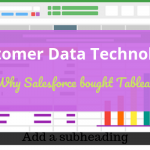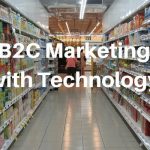
Data Management Platform and Ad Tech: Barclaycard on the Adobe Ad Cloud
Time to Read: 4.5 minutes
Last week, we attended an event on the Adobe Ad Cloud. To be exact, a Barclaycard marketer talked about her experiences with it. Before we dive in, let’s first take a step back and talk about what a data management platform (DMP) and ad technology can do. After all, we’ve talked a lot about marketing data. It’s high time we explore other aspects of marketing data – so what is the role of a data management platform and ad tech.
What is a Data Management Platform? What is Ad Tech?
A DMP ingests an organization’s customer and marketing data. It includes everything that touches a prospect and customer. Some examples are web behavior, email, CRM, ads, search, text messages – all across devices and systems. Toss in external data sources, too, such as third party sources. A data management platform is best when it’s comprehensive.
So what exactly is ad tech?
Ad technology is an ecosystem of technology that allows brands to advertise directly to consumers. In the old days, agencies bought and resold “ad space.” Now, thanks to ad tech, brands bypass agencies and directly buy and advertise to consumers. For sure, earlier generations lacked transparency. And while many of the early ad tech innovators faltered, competitors like Facebook and LinkedIn filled the gap and prosper.
So against this backdrop, Adobe purchased TubeMogul. It’s a technology to optimize video ads across all screens from desktop to streaming and broadcast TV. And with it came the new Adobe Ad Cloud.
Adobe Ad Cloud: A Self-service Platform for Managing Ad Creation and Delivery
For starters, it’s a self-serve platform for managing advertising in various formats. It’s an end-to-end programming solution that enables marketers and advertisers to create and rapidly deliver targeted content across multiple channels. This means social networks, all kinds of television, and search engines.
By giving marketers access to drag-and-drop ad design through integration with Adobe Creative Cloud, Adobe Ad Cloud is a real game-changer. All in all, it saves a lot of time without sacrificing advertising content quality.
Ultimately, Adobe Ad Cloud aims to be an alternative ad tech platform to walled gardens like Google and Facebook. Annually, it already manages billions in ad dollars from major companies. Further, it enables advertisers to purchase ad inventory in various marketing channels. For example, marketers can buy ads on live linear TV, addressable TV, connected TV, video-on-demand (VoD) and over-the-top (OTT). In addition, marketing uses its own first party data to make better buying decisions. Thus, marketers both improve targeting and spend.
So what’s not to like?
Barclaycard: A Case Study
Back to hearing about the Adobe Advertising Cloud for ourselves. The case study came from the Barclaycard Digital Acquisitions Lead. Barclaycard has enormous credit card operations and they are a marketing powerhouse. Together with the Adobe team, the Barclaycard marketer spoke about her experiences with the platform.
And results were pretty fascinating.
Check out our paraphrased summary of the question-and-answer session below for some compelling insights on this comprehensive platform.
Q: When you hear programmatic advertising, what does it mean at Barclaycard?
A: At Barclaycard, we’re performance marketers. So programmatic is multichannel and not only display ads. We’re still last touch attribution, though. With Adobe Ad Cloud, now we have scalability and more effective use of budgeting dollars.
Q: What are the best things about Ad Cloud?
A: Transparency and flexibility. We also like that we can always keep the same platform even if we change agencies. We knew we wanted a data management platform. And the Ad Cloud allows us to have flexibility, transparency, and to work with any agency. It also allows us to have data alongside creative resources, which is very useful.
Q: Are there any challenges you encountered?
A. Multi-touch attribution is still very difficult for us. Unless all traffic is going through one platform and sees everything, you’re not going to get that right story.
Another challenge that we’ve come across has been with our internal analytics. Because the Ad Cloud changes how we do things there. They’re still thinking, “How do we get all the cookie data into Oracle databases?” So we have to explain to them that not all analytics needs to be in-house or custom. It can be done within the platform itself.
Q: What types of data do you currently leverage?
A: Again, we’re into performance marketing, and not brand. We’re all about conversion. We use first party from our affiliate partners. Good examples, then, are customer data sources from airline or hotel partners.
We also have paid data, because first party data alone is often difficult in conversion. Only about 20% of data matches and gives me a good case. So for every 100, I get maybe 20 good cases, of people to whom I can market. Sometimes we complement first party data with second and third party data to help it become more effective.
Sometimes we complement first party data with second and third party data to help it become more effective.
All I can advise is that you test and learn. See what does best, test lists, test creative assets, and learn along the way. Data management platforms are great this way.
Q: Do you work with agencies and publishers directly?
A: We still rely on agencies very much. We prepare a media brief, and work with an agency to come up with a plan. Change happens in different places.
Q: Have you noticed any changes in viewability, or how much an ad is actually seen?
A: Before Ad Cloud, we had no choice but to believe the agency. Now, we can see how different publishers perform. So that’s a big change right there.
Q: What can you tell us about implementing Ad Cloud?
A: We work with Adobe in a managed services capacity. And we’re helping on campaigns alongside agencies. Adobe professional services are developing our in-house tech team skills.
Adobe Ad Cloud also offers direct relationships with publishers, so we can choose from over 100 premium sources and test to see how campaigns drive toward goals.
Q: How long did it take to implement Adobe Ad Cloud?
A: It took about three weeks. It went much faster, and much more smoothly, than anticipated.
Q: What’s next for Barclaycard on Ad Cloud?
A: We need to better cross-sell, so we’re trying to sell more to current customers. We’re experimenting. Now that the ad server plugs into internal systems, we working to leverage the system to market to current customers.
Q: What’s your advice to marketers looking to optimize their partnership in Adobe?
A: Invest in making sure people understand what you’re doing. Once you teach others about what you’re doing and why you’re doing it, you’ll get different results.
Summing up the evening: fantastic. Adobe always has fabulous hospitality and the Barclarycard marketer was enlightening. It was a real pleasure to learn from a marketing change agent who is integrating a data management platform and a new ad tech into the martech stack – who is also having tremendous positive impact.








